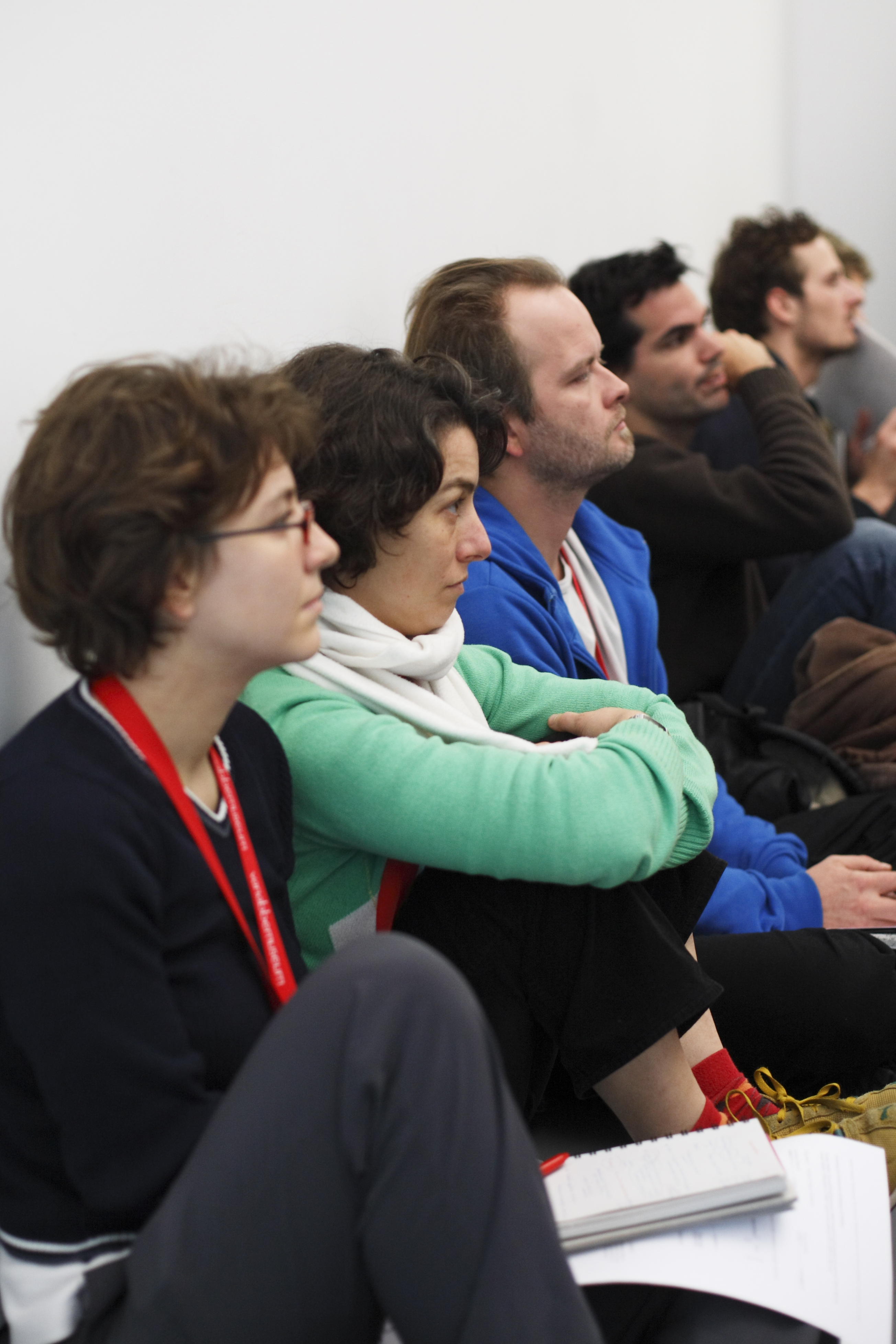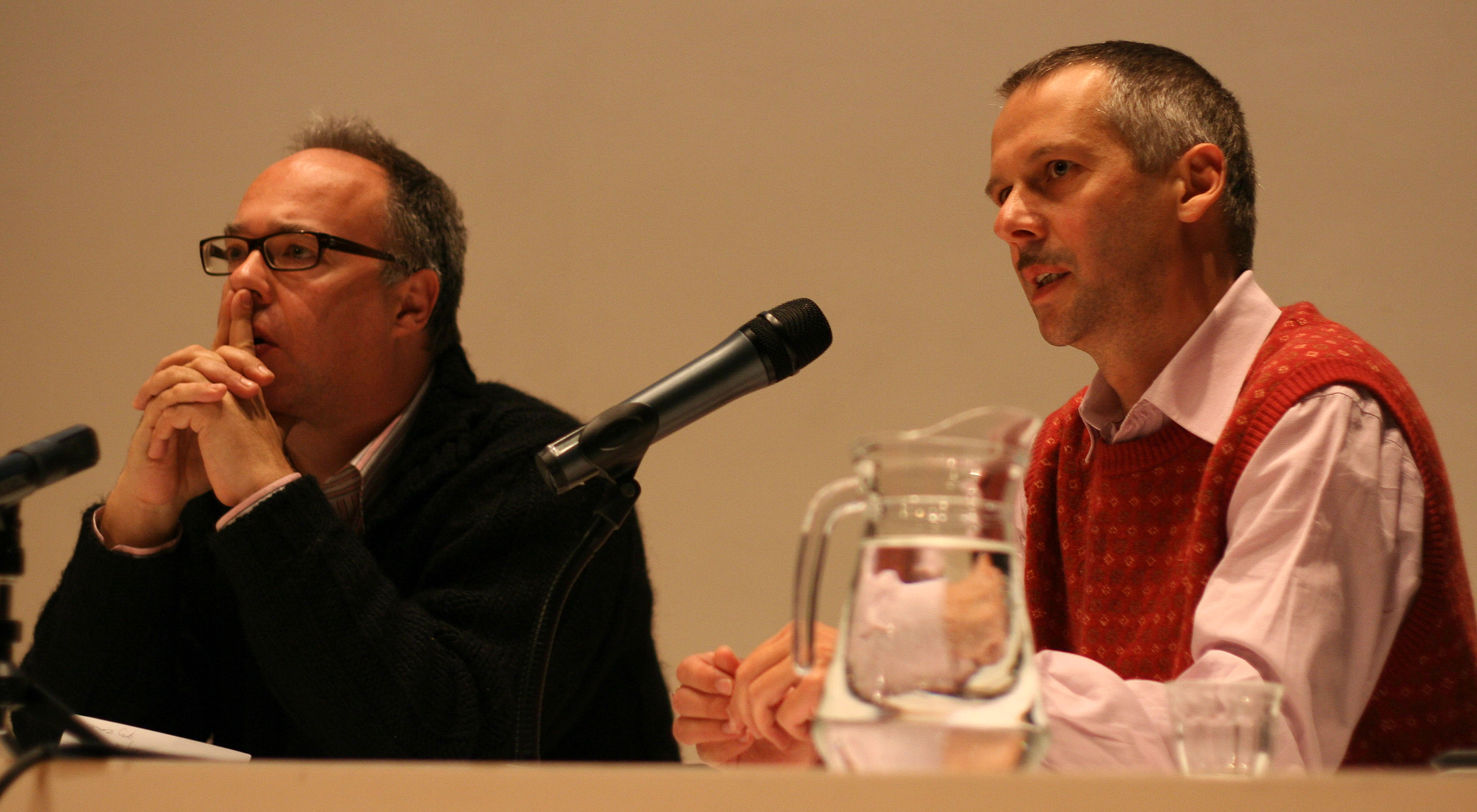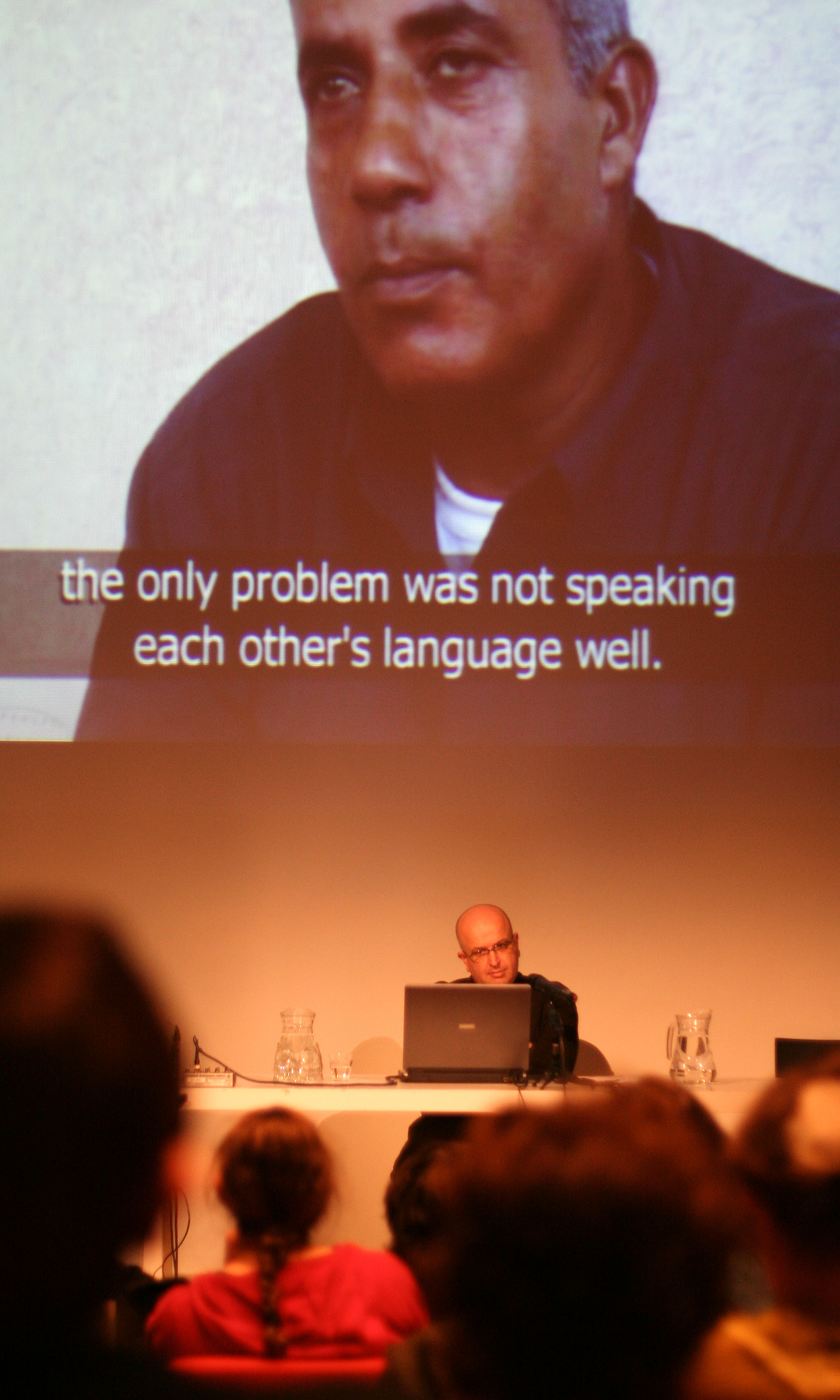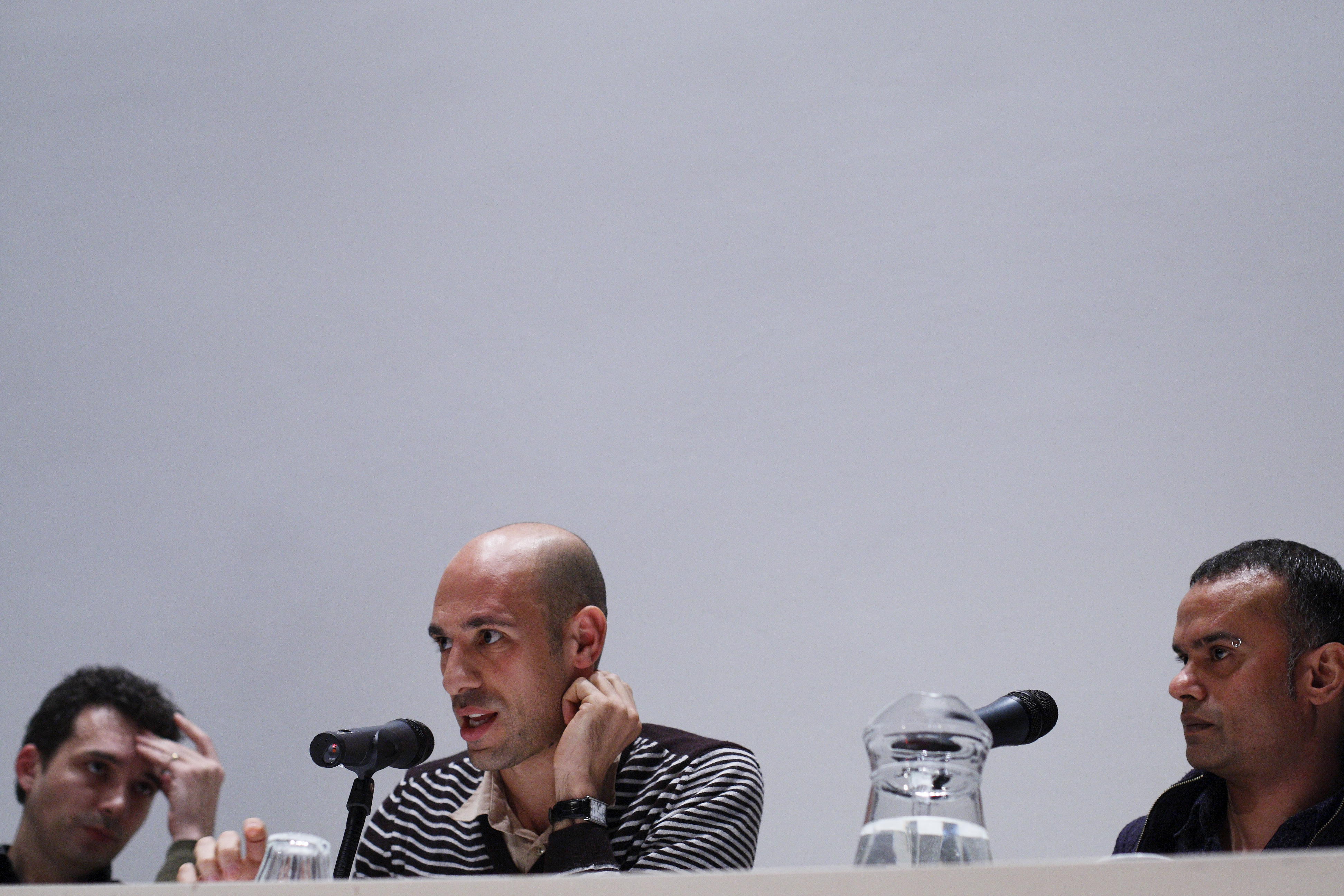 The audience was waiting with anticipation, ready for the workshop given by writer/journalist Abdelkader Benali. Unfortunately Abdelkader Benali was stuck in traffic. Although Holland is a relatively small country, the traffic is an absolute nightmare, especially on a Friday afternoon. But the visitors didn’t mind. Everyone just got an extra cup of coffee and waited patiently. Continue Reading »
The audience was waiting with anticipation, ready for the workshop given by writer/journalist Abdelkader Benali. Unfortunately Abdelkader Benali was stuck in traffic. Although Holland is a relatively small country, the traffic is an absolute nightmare, especially on a Friday afternoon. But the visitors didn’t mind. Everyone just got an extra cup of coffee and waited patiently. Continue Reading »
 On to the streets, into the city and look for a confrontation with other people. That seemed tot be the central thema during the presentations of a couple of artists of the Caucus, wednesday morning. Michael Smit, Bastiaan Arler and Allard van Hoorn showed some of their work to the other Caucus-participants.
On to the streets, into the city and look for a confrontation with other people. That seemed tot be the central thema during the presentations of a couple of artists of the Caucus, wednesday morning. Michael Smit, Bastiaan Arler and Allard van Hoorn showed some of their work to the other Caucus-participants.
 De straat op, de stad in en de confrontatie aangaan met de mensen. Dat leek woensdagochtend het centrale thema te zijn tijdens de presentaties van een aantal kunstenaars van de Caucus. Michael Smit, Bastiaan Arler en Allard van Hoorn lieten hun werk zien aan de andere Caucusdeelnemers
De straat op, de stad in en de confrontatie aangaan met de mensen. Dat leek woensdagochtend het centrale thema te zijn tijdens de presentaties van een aantal kunstenaars van de Caucus. Michael Smit, Bastiaan Arler en Allard van Hoorn lieten hun werk zien aan de andere Caucusdeelnemers
“What is missing in art” sounds from a megaphone. A couple of meters ahead, a man empties a bottle of milk in the Dommel River, next to the Van Abbemuseum. He walks up to the man with the megaphone and receives a piece of paper. The paper goes into the bottle, the bottle is closed and the next question already resounds over the water of the Dommel.

 “What is missing in art”, klinkt uit een megafoon. Een paar meter verder leegt een man een fles melk in de Dommel naast het Van Abbemuseum. Hij loopt naar de persoon met de megafoon en neemt een vel papier in ontvangst. Het papier gaat in de fles, deksel erop en de volgende vraag galmt alweer over de Dommel.
“What is missing in art”, klinkt uit een megafoon. Een paar meter verder leegt een man een fles melk in de Dommel naast het Van Abbemuseum. Hij loopt naar de persoon met de megafoon en neemt een vel papier in ontvangst. Het papier gaat in de fles, deksel erop en de volgende vraag galmt alweer over de Dommel.
 Als een pater familias zit Charles Esche aan het hoofd van het gezelschap. In de ruimte vol bijzonder artistieke stoelen zijn de deelnemers van de Be[com]ing Dutch Eindhoven Caucus bijeengekomen om onder leiding van Esche te discussiëren. Missie voor vandaag: definiëren wat ‘Nederlander zijn’ precies inhoudt. Dit is lastig weten we al uit eerdere lezingen discussies, want wat is identiteit, en als we dat al niet weten, hoe kunnen we dan bepalen wat nationale identiteit is? Enfin, genoeg stof om over te praten. Continue Reading »
Als een pater familias zit Charles Esche aan het hoofd van het gezelschap. In de ruimte vol bijzonder artistieke stoelen zijn de deelnemers van de Be[com]ing Dutch Eindhoven Caucus bijeengekomen om onder leiding van Esche te discussiëren. Missie voor vandaag: definiëren wat ‘Nederlander zijn’ precies inhoudt. Dit is lastig weten we al uit eerdere lezingen discussies, want wat is identiteit, en als we dat al niet weten, hoe kunnen we dan bepalen wat nationale identiteit is? Enfin, genoeg stof om over te praten. Continue Reading »
 “The lights dim slowly, but I am also very slow”, says German Roger Buergel before he starts his keynote lecture Beyond Identity and Difference. Is the artistic director of the famous contemporary art event Documenta XII (2007) referring to the fact that he was delayed and the timeschedule had to be changed? Or does he refer to the tempo in which he gives his lecture? He speaks slowly and gentle, and that’s a good thing.
“The lights dim slowly, but I am also very slow”, says German Roger Buergel before he starts his keynote lecture Beyond Identity and Difference. Is the artistic director of the famous contemporary art event Documenta XII (2007) referring to the fact that he was delayed and the timeschedule had to be changed? Or does he refer to the tempo in which he gives his lecture? He speaks slowly and gentle, and that’s a good thing.
 “Het licht dooft hier langzaam, maar ik ben ook een beetje langzaam”, zegt de Duitse Roger Buergel voordat hij start met zijn keynote lecture Beyond Identity and Difference. Zou de artistiek directeur van het wereldberoemde evenement voor hedendaagse kunst Documenta XII (2007) refereren aan het feit dat hij later was dan gepland en het schema omgegeooid moest worden? Of verwijst hij naar het tempo waarop hij zijn lecture geeft? Dat is namelijk heel rustig. En dat is maar goed ook.
“Het licht dooft hier langzaam, maar ik ben ook een beetje langzaam”, zegt de Duitse Roger Buergel voordat hij start met zijn keynote lecture Beyond Identity and Difference. Zou de artistiek directeur van het wereldberoemde evenement voor hedendaagse kunst Documenta XII (2007) refereren aan het feit dat hij later was dan gepland en het schema omgegeooid moest worden? Of verwijst hij naar het tempo waarop hij zijn lecture geeft? Dat is namelijk heel rustig. En dat is maar goed ook.
 Italian-born multimedia artist Mario Rizzi is slightly hidden behind his laptop when he introduces himself to the audience. The 35 participants of the Be[com]ing Dutch Eindhoven Caucus have just had lunch and a short break to clear their minds from brain teasing discussion points brought in by the morning panel. They listen silently to the man that has acquired international recognition by collecting other peoples life stories.
Italian-born multimedia artist Mario Rizzi is slightly hidden behind his laptop when he introduces himself to the audience. The 35 participants of the Be[com]ing Dutch Eindhoven Caucus have just had lunch and a short break to clear their minds from brain teasing discussion points brought in by the morning panel. They listen silently to the man that has acquired international recognition by collecting other peoples life stories.
 Als vervolg op de conversatie van vanochtend tussen Paul Scheffer en Louk Hagendoorn wordt er verder gediscussieerd over de vraag: “Kan kunst gebruikt worden om van de wereld een betere plek te maken?” Met een panel van de dramaturg Igor Dobricic, auteur Abdelkader Benali en professor media en cultuur Sudeep Dasgupta wordt deze opmerking van Scheffer verder uitgediept.
Als vervolg op de conversatie van vanochtend tussen Paul Scheffer en Louk Hagendoorn wordt er verder gediscussieerd over de vraag: “Kan kunst gebruikt worden om van de wereld een betere plek te maken?” Met een panel van de dramaturg Igor Dobricic, auteur Abdelkader Benali en professor media en cultuur Sudeep Dasgupta wordt deze opmerking van Scheffer verder uitgediept.